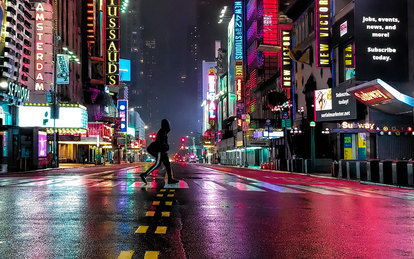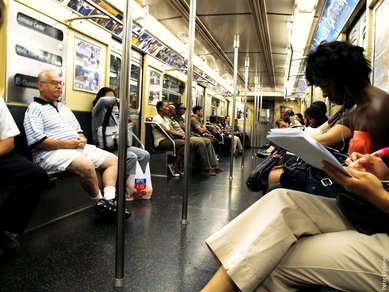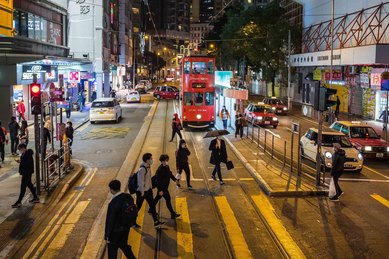应对新冠疫情,重新确认城市固有和持久的价值

42nd Street on a Saturday Night during COVID-19. Credit: Vladislav Grubman
As the COVID-19 pandemic has continued to advance across the globe, one of the most cited and effective methods to slow its spread has been “social distancing,” in which individuals maintain physical distance from one another. These strategies have been effective in stunting the exponential spread of the disease. They have also emptied nonessential businesses, universities, schools, museums, places of worship and other facilities that bring people together for shared experiences, coordination, communication, and mutual development.
The losses we’re experiencing are more than economic. Such collective experiences form the foundation of civic life and support a common understanding and a shared urbanity. Ideas, goods, services and culture intermingle to form the rich environments that have inspired human innovation over millennia. This mixture of uses and experiences acts as a progenitor of social cohesion and exchange, and remains the bedrock of our cities and our societies.
Yet today, in response to COVID-19, many writers are thoughtfully, and at times uncontrollably, outlining the myriad ways in which our cities have not only gone temporarily quiet, but have experienced a permanent shift in their value and relevance.
In some cases, such responses are a personal catharsis, such as David Freedlander’s recent piece in Politico, in which he writes, “I wish I could say that the New York we knew will return soon, that the people who post their phone numbers on telephone poles and invite their neighbors to call if they need food or medicine delivered or the people who go to their balconies to cheer health care workers every day at 7 p.m. show the spirit and resiliency of the city, and that, like after 9/11, we will build back better than before, but I can’t right now. One day, perhaps, but not now. It is impossible to look on New York and not despair.”
Freedlander’s emotion over COVID-19’s impact is visceral and clear, signaling deeper changes in his perception of safety and sense of place that many are currently struggling with.
But other writers and critics are seeing a moment to rally around an implicit and opportunistic interpretation of the relationship between density and the spread of COVID-19, arguing that urban density itself represents a long-term threat. The headline for Joel Kotkin’s April 26 op-ed in the Los Angeles Times was “Angelenos like their single-family sprawl. The coronavirus proves them right.” Public transportation bears the brunt of Kotkin’s urban critique, who goes on to write, “The experience of the current pandemic is not likely to prove a great advertisement for living cheek by jowl, riding on a crowded subway or getting to work on a busy commuter train. They are the very factors that some researchers, including urbanists like Richard Florida, link to New York’s extraordinary exposure to the virus.”
Florida does identify mass transit as one of a number of higher-risk essential services and employment sectors that are impacting some cities more than others at the moment. However, it is important to note that he reaches very different conclusions about the value of urban density and proximity than Kotkin. For Florida the city isn’t just a thing in which major –- even devastating -– challenges cripple our economies, cultures and opportunities; it is also a unique environment, imbued with our human capacity to reason, strategize, and persevere. As Florida outlines in a recent article for the Brookings Institute, “No pandemic or plague or natural disaster has killed off the city, or humanity’s need to live and work in urban clusters. That’s because cities’ concentration of people and economic activity—which serves as the motor force for innovation and economic growth—is just too strong.”
In Kotkin’s analysis, social distancing is expanded to a broader argument regarding a cause and effect relationship between density and COVID-19 spread, and the viability of dense cities in the future. While it’s clear close personal proximity is a key factor in the disease’s spread, these arguments tend to focus on those spaces and moments in which people are compelled to come together (such as mass transit), not the full dimension of city living. Moreover, they do not reflect actual statistical growth in cases, but more often represents absolute numbers and their related growth. For instance, according to the CDC, “Among the 10 jurisdictions reporting the most cases, doubling time ranged from 5.5 days in Louisiana to 8.0 days in NYC. During March 31–April 7, the overall cumulative incidence of COVID-19 increased by 63.4 cases per 100,000.”
Furthermore, these case estimates do not include the massively underestimated number of positive COVID-19 cases among homeless populations, such as those in Los Angeles, nor do they recognize that Los Angeles and Los Angeles County rank as second in the United States for overall homeless population. They also do not reflect the increasing growth of poverty clusters in many U.S. suburbs, where sprawl does not necessarily represent a lifestyle preference.
Equally important in an examination of how urban centers, suburbs and rural areas fare during pandemics is the reality that many of those seeking care (of any kind) may not have access to a private vehicle (whether their own or through rideshare). One need only reflect on available mapping from the New York Times illustrating the alarmingly long travel times for those in less dense and rural areas to understand the consequences of this thinking. According to the Times, “As the coronavirus outbreak spreads into rural parts of the United States, more people who live far from a hospital are increasingly likely to need one. That poses challenges for communities where hospitals are scarce and I.C.U. beds are in short supply — even a relatively small outbreak there could overwhelm medical resources, with potentially grim consequences for public health.”
In her reaction to the recent spate of articles questioning whether cities can ever be the same again, Jennifer Bradley, the Aspen Institute’s Director for the Center of Urban Innovation, makes a compelling case for “safe density.” She also tackles the question of whether remote work will become the hallmark of a de-densified new normal:
“Cities are the antithesis of social distancing. . . Cities thrive not just on proximity, which technology can replace to some extent, but on the superbly generative mixture of proximity, spontaneity, and diversity. Despite predictions since at least the mid 1990s, telecommuting and remote work have not replaced office buildings. Instead they caused people to recreate a kind of office in coffee shops and coworking spaces. In fact, as Edward Glaeser observed in Triumph of the City, advanced communications technology has actually made face-to-face connections more valuable. Despite some perfervid headlines, we are far from urbanization being “thrown violently in reverse” nor are we sowing “the seeds of a wholesale shift in where and how Americans live.”
If the perceived take away from COVID-19 is that we simply must embrace a dispersed suburban, auto-centric density we must not only consider the inherent inequities in this proposition, but also take into account a broader -– and arguably even more impactful -– outcome: climate change and the long-term impacts of increased consumption and carbon generation. When taken in sum total –- at a time in which climate-related strains on global economic systems and larger nation-state vulnerabilities are increasing –- the simple proposition to have more people living further apart in insulated neighborhoods, using private transportation, may strike many of us as an untenable model with consequences that ultimately eclipse those presented by the current pandemic.
One need only to review the University of California-Berkeley’s interactive carbon footprint map and calculator to reveal the fundamental carbon footprint differences between zip codes. The findings are startling and demonstrate the vital importance to have informed, balanced and thoughtful consideration of future development approaches, especially those that seem to purport the advantages of suburban development patterns for the sake of public health and long-term viability.
And finally, if there remains a fundamental lack of confidence that cities, given their densities, can be effective responders to future pandemics, one need only to understand the way some of the densest cities on the planet effectively engage such challenges and prove valuable methods for future similar challenges.
In the case of Hong Kong, its past brush with SARS prepared city leaders with the policies, tools and systems to engage the outbreak of COVID-19. Put quite simply, they learned from the past and applied the relevant tools and insight -– forged through previous challenges -– to create a clear and impactful response. As Lian-Hee Wee explains, via CNN10 (a digital news media platform for children), “SARS has remained very fresh in the memories of Hong Kongers, and when the COVID-19 broke out people knew we would need masks, we would need to be away from one another and we would need to start becoming very hygienic about things. We would need to listen to the medical people, we would need to close borders. It’s the basic protocol that can be found in any government in cases of pandemics and crises, the Hong Kong people knew exactly what to do, and they did it.”
Here, Hong Kong -– when compared with early COVID-19 responses from similar cities such as Singapore -– better leveraged its experience and population mindset to address the challenge, maintaining low infection rates based on the policies it deployed.
We are also seeing more opportunistic portrayals of past (and by implication potentially imminent) urban adaptation and innovation in response to infectious disease. Not unlike the ways in which we describe the human immune system responding to infections and building up long-term defenses, Jack Shenker writes in the Guardian, “Without a series of devastating global cholera outbreaks in the 19th century -– including one in London in the early 1850s that claimed more than 10,000 lives -– the need for a new, modern sewerage system may never have been identified. Joseph Bazalgette’s remarkable feat of civil engineering, which was designed to carry wastewater safely downriver and away from drinking supplies, would never have materialised.”
While one could argue such innovations would have occurred eventually -– if only on a slower trajectory –- without the calamitous impact of cholera, the outbreak defined a clarion call for hygienic, strategic and systemic responses necessary to improve public health in the world’s cities.
As we move forward with COVID-19 and any future pandemic, it will be vital for us -– as a collective global population -– to take the time to understand the intrinsic and multifaceted positive benefits cities and urbanized areas provide us. Rather than mounting anti-density campaigns, we should stop to better understand how thoughtful policy, prudent decision-making, and informed regulation can create safe environments that ensure our cities remain the vital centers of advanced economic, social, and (yes) ecological performance. Moreover, we need to realize that cities will not only provide equitable platforms for many to realize more opportunity over time, but they will also continue to be – as they have for millennia – the undisputed progenitors of innovation and exchange we will need to adapt and thrive together.




